State of the art technology has allowed scientists an insight into how brain chemicals prompt people into addictive behaviour.
Experiments on rats reveal that the brain appears to release a neurotransmitter called dopamine before and after a dose of cocaine.
This “reward” chemical may contribute to the “vicious circle” of drug addiction, say researchers.
The first dopamine dose is a small “taster”, which appears to prompt the rat into looking for a dose of the drug.
The second, much larger dopamine release happens when the cocaine is taken. The results were produced because, for the first time, scientists managed to detect even millisecond-long pulses of dopamine release in the brain.

Cocaine: Rats trained to want it
Dr David Self, University of Texas Southwestern Medical Center
Prompt and reward
Electrodes implanted in an area of the forebrain called the nucleus accumbens allowed them to see the first “priming” dose of dopamine as well as the massive “reward” dose.
“As a rat chases its tail, so drug addicts may suffer a similar vicious circle of priming and reward controlled by these dopamine signals”
Dr David Self, University of Texas Southwestern Medical Center
Their rats had been trained to press a lever and receive cocaine injection.
They had learned to associate a flash of light and a particular tone with the drug.
When the light came on independently, dopamine levels began to rise as the rat hunted for the cocaine-releasing lever.
Electrical stimulation of the brain cells which produce dopamine also seemed to trigger this hunt for Cocaine.
The researchers, from the University of North Carolina at Chapel Hill, say this is an “unprecedented” finding.
They wrote: “This demonstrates that ‘subsecond’ dopamine has a pivotal role in drug-seeking behaviours.”
Understanding how the brain reacts to drug stimulation may offer clues to scientists trying to find ways to call a halt to the cycle of drug taking and seeking among addicts.
Dr David Self, from the Department of Psychiatry at the University of Texas Southwestern Medical Center, said that it was a “chicken and egg” situation.
He said: “Dopamine acts as a reward for behaviour that precedes its release, and subsequently it triggers pursuit of the same reward after its release.
“As a rat chases its tail, so drug addicts may suffer a similar vicious circle of priming and reward controlled by these dopamine signals.
“Therapies aimed at preventing one or both of these signals could be effective treatments for addiction.”
Mohammed Shoaib, of the charity Action on Addiction, said: “These remarkable findings highlight the role for dopamine in both drug-seeking and drug-taking behaviour.
“The rapid changes in dopamine levels triggered by the cues demonstrate the powerful learning processes that are involved in cocaine dependence, and reveal why it can be so difficult to give up. It’s like giving a dog a biscuit for bad behaviour.”
“Future research efforts should focus on finding drug treatments which disrupt this reward system so that cocaine addicts can be treated more effectively.”